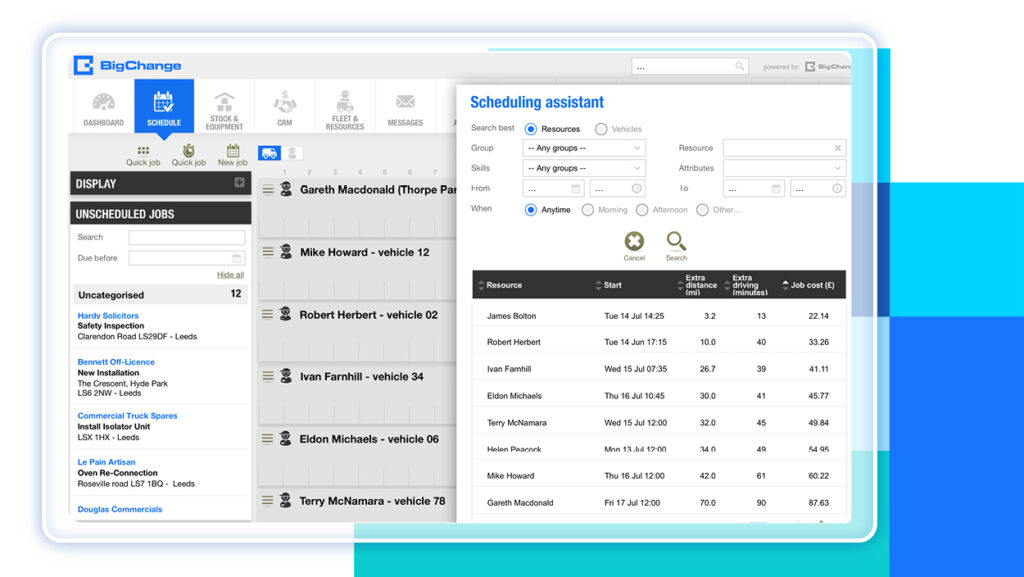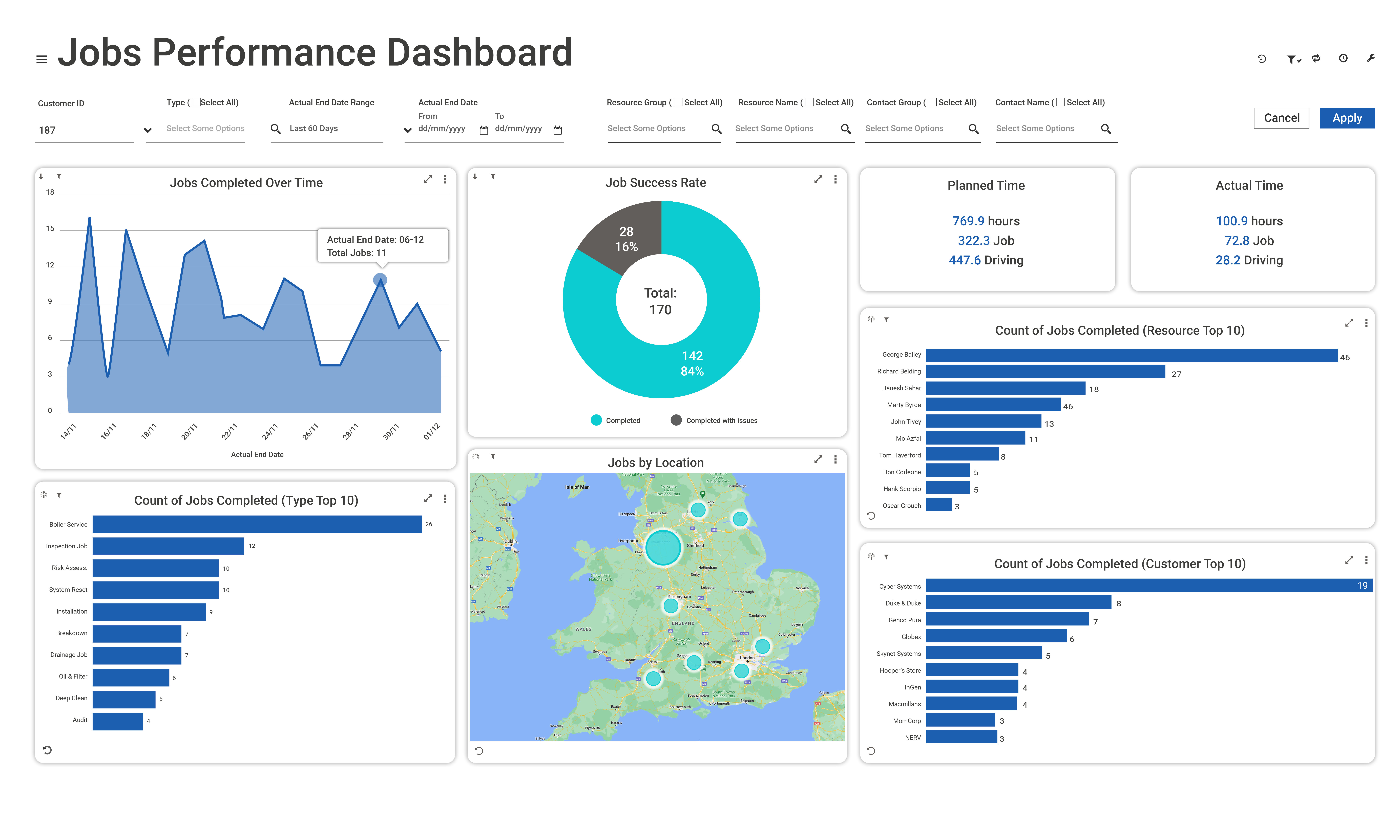Job scheduling is about getting the right people to the right places at the right times, with the right tools. Sounds simple enough? But as you know, it's easier said than done. Get it right, though, and your productivity shoots up, your customers are happier, and your team aren't running around like headless chickens.🏃♂️
Time is precious. Use it wisely with 15+ ways to streamline your job scheduling, including tips on game-changing tech that will save you tons of time.
To make it extra helpful, we’ve included tips to accelerate and elevate your everyday operations—and peppered it with insights from some of the most successful field services businesses we know.
Understanding the basics of job scheduling
Let's start at square one: what exactly is job scheduling? In the simplest terms, job scheduling is about planning who does what, when, and where. Why is it so crucial, you ask? Without a solid plan, your team might end up in the wrong place at the wrong time, or worse, doing the wrong job!
Effective scheduling is the secret sauce that helps you avoid these mix-ups. It ensures that your team is productive, your resources are used wisely, and your customers are happy. Plus, it keeps stress levels down, and who doesn't want a more relaxed work environment?
Whether it's an urgent repair job or a regular maintenance check, getting your scheduling spot on means you're always ready to roll with the punches🥊. (For more on understanding job scheduling, you can read our job scheduling guide.➡️)
Now that we’ve covered the basics, let’s get into some tips to streamline your entire operations.
15+ job scheduling tips for your field service management business
If you’re looking to improve job scheduling, you’re in the right place. Here’s a round-up of our top job scheduling tips to boost operations, efficiency, and cash flow.
Tip #1: Use job scheduling software to make scheduling easy
Let's face it, we live in a digital world, and it's high time your job scheduling caught up. So the first step to streamlining job scheduling is to improve your current approach with job scheduling software. This ensures nothing slips through the cracks and everyone sees what needs to be done.
It’s key to choose a tool that streamlines processes. The less double-entry you need to do and the fewer screens you need open, the fewer clicks it takes to schedule jobs.
As Charles at Cornwall Waste points out, the right job scheduling software slashes admin and helps react to changing schedules. “Slashing administration and automating workflows means we no longer produce reams of paper, and connecting our mobile workforce with the back-office means we have 24/7 visibility so we can easily answer customer queries or react to changing schedules.”
Tip #2: Identify and prioritise urgent jobs
As with everything, knowing what to tackle first (and in which order) is crucial. You need a way to keep an eye out for urgent jobs that need immediate attention. Job scheduling tech can help with this by alerting you to priority tasks and enabling quick and easy rescheduling to accommodate urgent jobs.
This was key for HTF Transport; “BigChange gives us 24/7 visibility of our operation which means we can be reactive and make timely decisions based on evolving situations and on-site circumstances. It also provides the mechanisms to share this information with our customers and partner organisations to improve service levels.”
Tip #3: Use templates to boost efficiency and remove errors
Create standard templates for regular jobs or common task types. This streamlines the scheduling process, reduces the likelihood of missing crucial steps, and ensures consistency across all jobs.
Consider including digital job cards with checklists of required tools and parts, and any safety requirements etc, so engineers arrive fully prepared. Tailoring templates to specific job types also aids with accurate time estimates and allocation.
Tip #4: Customise templates with your brand
Tailor these templates to include your branding and specific service details. It not only looks professional but also ensures that your team is familiar with the format, reducing confusion and enhancing efficiency.
Branded templates also promote your business to customers receiving appointment details and reminders.
Tip #5: Get GPS integration for optimised routing
Integrate GPS functionality to optimise travel routes for engineers. This not only saves time and fuel but also allows for more jobs to be completed in a day, increasing overall efficiency.

GPS tracking also provides real-time traffic updates so delays can be taken into account, and you can then message customers with updated ETAs.
Tip #6: Group jobs for job scheduling efficiency
When planning, look for opportunities to group jobs by location or type. This reduces travel time and allows for more jobs to be completed in a day, increasing overall productivity.
Users can also import recurring job-group templates, set up customer-specific job sheet template and create templates either against a sales opportunity or contract. You can even take this one step further and analyse historical data to identify trends for when and where job groupings make the most sense.
Tip #7: Reduce duplication
Duplication spells double trouble for busy field service businesses. You’re wasting time and money doing things twice. For example, entering and storing the same information in different systems not only wastes time but increases the risks of errors.
Integrated systems also reduce the chance of outdated information in one system causing confusion. So look for opportunities to integrate systems together.
Tip #8: Automate routine tasks
Identify tasks that can be automated, such as appointment reminders, follow-up emails, and regular maintenance schedules. Automation not only saves time but also reduces the risk of human error.
Build work processes to trigger automated tasks so they happen without any effort from your staff.
Tip #9: Create automated processes
Beyond routine tasks, look at automating entire operational processes. For instance, automatic job assignment based on skill set and location, or automated invoicing once a job is marked complete.

These processes streamline your operations and ensure consistency.
Tip #10: Give your engineers mobile access
Mobile access to scheduling tools is a game-changer. It allows your engineers to receive real-time updates, access job details on the go, and update job statuses from the field. This connectivity improves efficiency and customer service.
Mobile apps were a game changer for Hodge Clemco; “our engineers automatically receive job sheets which are completed, using the mobile app, whilst on-site and are instantly available for the back-office team to access. This means we are currently about 80 per cent paperless, and improving all the time. We have doubled the number of engineers we employ without having to add any additional support staff and we are hitting KPIs for quotations and customer reporting.” Andy Peart, Sales & Service Director, Hodge Clemco
Tip #11: Offer self-service scheduling to clients
If possible, implement a self-service scheduling feature for your customers. This allows clients to book and manage their appointments online, reducing administrative workload and improving customer satisfaction.

Having a customer booking portal was game-changing for Precision FM; “BigChange’s job scheduling software allows us to better streamline our processes by linking the servicing portal with our sales and CRM functions and will empower our teams to offer our customers the innovative solutions they need.”
Tip #12: Integrate inventory management for seamless operations
You could also think about linking your job scheduling with inventory management. This ensures that engineers have the necessary parts and tools for each job, reducing delays and increasing first-time fix rates.
This was important for Blackhall; “From initial enquiry, right the way through to invoicing and payment; BigChange allows us to capture and record information and share it within the business to inform decision making, and with our customers to improve service levels.” Stuart Blackhall, Business Director, Blackhall Plumbing and Heating
Tip #13: Enable custom reporting for informed decision making
Use the custom reporting features of your scheduling software to generate insights into business performance. This can include engineer efficiency, customer satisfaction ratings, and peak service times.

Here’s how HFT Transport put this feature to good use; “it’s not all about the day-to-day decisions. BigChange provides the intelligence we need to make strategic, long-term decisions that support sustained growth and will help ensure the next 30 years of our business.”
“with better job scheduling and reduced empty running, and we can look at the profitability of each job.
Tip #14: Automated customer notifications and reminders
Set up automated notifications and reminders for customers about their appointments. This feature reduces no-shows and enhances customer experience by keeping them informed.

Tip #15: Implement predictive scheduling for future planning
Some advanced job scheduling software includes predictive analytics. Utilise this to anticipate busy periods and plan resources better. This proactive approach can significantly reduce last-minute scrambles.
Streamline everything with job scheduling software
Effective job scheduling is essential. By planning who does what, when, where and in which order, you ensure jobs are completed on time, engineers and resources are used efficiently, and customers stay satisfied.
As we have seen in the above tips and examples, introducing job scheduling software and automation takes your operations to the next level by reducing errors, duplications, and delays.
The result is a smooth-running business where engineers arrive fully prepared to complete work the first time.
Implementing some of the tips shared here will transform how you schedule jobs. Your team will find themselves with up-to-date information at their fingertips, guided by optimised routes to jobs.
Customers benefit too, with self-service options and automated updates that improve experience. And the business gains the insights needed to keep growing and staying competitive.
See how you can schedule jobs the right way with BigChange: We’d love to talk.










